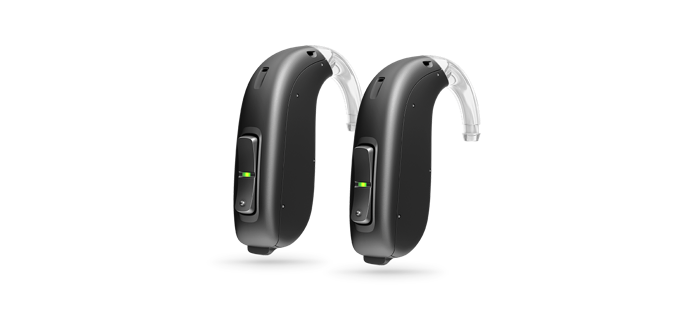Behind-the-Ear: BTE
aids supply significant power, long battery life and a variety of
features for the wearer

DEVICE APPEARANCE
Behind-the-Ear Device
Appearance
The Behind-the-Ear (BTE) hearing aid first emerged in the late 1990s, and it signaled the resurgence of BTE hearing aids in comparison to their ITE counterparts. It has the cosmetic advantage of the CIC in that it is not easily visible to others; yet it has sufficient “real estate” to provide more features and power of the ITC and ITE hearing aid styles. This style of hearing aid has surpassed the full-shell ITE (which fills the entire outer bowl of the ear), sitting behind the outer ear, with tubing that routes the sound into the ear canal.


Sound Notes
Sound Amplifications and Venting
As with the in-the-ear hearing aid styles, the BTE has a tiny microphone(s) that pick up the sound, the amplifier amplifies it, and a speaker sends this sound through the thin tube which ends in a rubber bud or “dome” inside the ear canal. The vents of the ITE styles were built into the body of the hearing aids themselves. The dome of the thin tube BTE that sits inside the ear canal has vent holes to allow air into the ear canal, this “open fitting” results in a natural open feeling for the wearer.
Try Our Online
Hearing Test
Concerned about your hearing? Try our free no
obligation hearing screening test. This interactive test will
help you determine whether a professional consultation
would benefit you.

CUTTING-EDGE HEARING AIDS
Which Hearing Device Is Right for You?
BTE: Behind the Ear
Learn More
CIC: Completely in
Canal
Learn More
Extended Wear
Learn More
IIC: Invisible in Canal
Learn More
Mini-Canal
Learn More
ITC: In the Canal
Learn More
RIC: Receiver in Canal
Learn More
PROS AND CONS
Determining Whether BTE Hearing Aids Are Right for You
The BTE hearing aids are suitable to most ranges of hearing loss and are suitable for children. The relative positions of the speaker and microphone in this style helps with the issue of feedback that happens when the amplified sound produced by the hearing aid speaker is picked up by the hearing aid microphone.
As the speaker sits above the ear far from where wax is produced inside the canal this style hearing aid is easier to clean and maintain than those in the ear or canal. BTE wearers may detect wind noise with this style. It’s important to discuss all the options with your hearing health practitioner to ensure you find the hearing aid that will work best for your unique preferences.


HEARING AID TECHNOLOGY
Options to Consider When Selecting a Hearing Aid
The BTE can accommodate larger-sized batteries and is available in rechargeable solutions. Modern Bluetooth connectivity to other devices including smartphones, TVs, computers, music players, and remote microphone accessories is possible in most BTE models. Digital hearing aids have advanced processors that provide better sound quality and speech understanding in background noise.
ANSWERS ABOUT HEARING AIDS AND MORE
Frequently Asked Questions
The listening device in a behind the ear hearing aid should sit behind the outer ear. A tube attaches the listening device to an ear mold that fits in the ear, or a soft dome which sits in the opening of the ear. The type of dome a behind the ear hearing aid uses will depend on the make and model of the device.
Yes, every behind the ear hearing device allows for volume control. To change the volume on a behind the ear hearing aid, quickly press the buttons on the listening device on your outer ear to adjust the volume up or down. You will hear a high-pitched beep which will indicate that you have increased or decreased the volume.
Most hearing aids, not just behind the ear devices, are made to be moisture resistant but not waterproof. A few raindrops, or sweat won’t damage the device, but excessive exposure to water can cause damage. We recommend removing the hearing aid before showering or going swimming.
The design of a behind the ear hearing aid allows it to be larger than other types of hearing devices. This means it can house a more powerful battery, a more powerful microphone, more powerful sound amplification, and additional features that aren’t possible in some smaller devices. One important thing to note is that while this style of hearing aid can be larger than others, it is still quite discreet and can be matched to skin tones and hair colour to appear more naturally when worn.
A behind the ear hearing aid can be a suitable option for any due to its versatility and additional features. Having a more powerful battery than other types of hearing aid means more powerful sound amplification which makes them a great option for people with moderate to severe cases of hearing loss. The additional features on some models of behind the ear devices, such as Bluetooth connectivity also make them great options for younger people as well as anyone who is technologically savvy and would like to control their hearing aid through their mobile device.
We would love to
hear from you!
assessment or hearing devices the professionals at NexGen Hearing
have the answers. Send us your contact information and we’ll be in
touch. Remember, there’s never any obligation and you’ll never be
pressured to make a purchase! We’re here to help!
Head Office
201 – 4500 West Saanich Rd.
Victoria, British Columbia
Canada, V8Z 3G2